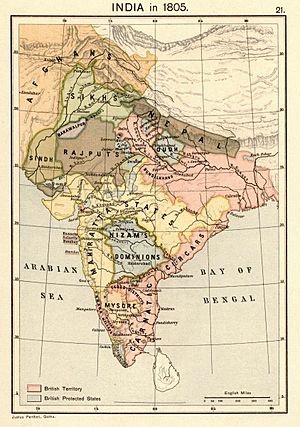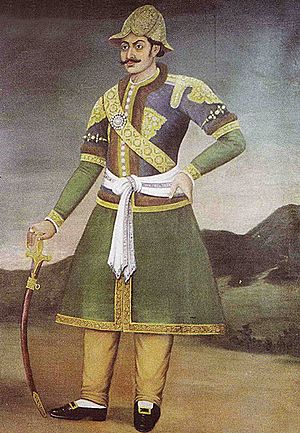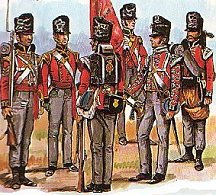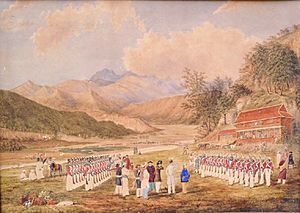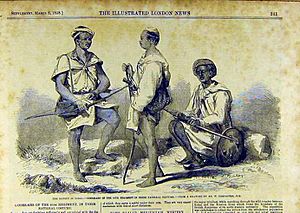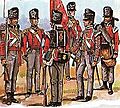Anglo-Nepalese War facts for kids
Quick facts for kids
Anglo-Nepalese War
|
|||||||||
|---|---|---|---|---|---|---|---|---|---|
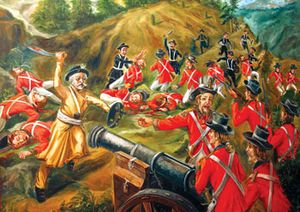 Bhakti Thapa (yellow) leading Nepalese Gurkhali Army against British forces |
|||||||||
|
|||||||||
| Belligerents | |||||||||
| Commanders and leaders | |||||||||
|
|||||||||
| Strength | |||||||||
|
First campaign:
100,000 Indian mercenaries during both campaigns. |
a little more than 11,000 | ||||||||
| Casualties and losses | |||||||||
| Unknown | Unknown | ||||||||
The Anglo-Nepalese War (November 1, 1814 – March 4, 1816) was a conflict between the Gorkhali army of the Kingdom of Nepal and the British forces of the East India Company (EIC). Both sides wanted to expand their control in the mountainous northern part of the Indian Subcontinent. The war ended with the signing of the Sugauli Treaty in 1816. This treaty gave some Nepalese land to the EIC.
The British war effort was led by the East India Company. They had help from local states like the Garhwal Kingdom, the Patiala State, and the Kingdom of Sikkim. The Kingdom of Gorkha's war effort was mainly led by two powerful families: the Thapa dynasty and the family of Amar Singh Thapa.
Contents
Why the War Started
Before the war, both the British and the Nepalese were expanding their territories. Nepal was growing into Sikkim (east), Kumaon and Garhwal (west), and Awadh (south). The British East India Company was also getting stronger in India. This expansion led to clashes.
Trade and Control
The British wanted to trade with Tibet through Nepal. They sent people to ask Nepal to open its borders for trade, but Nepal refused. The Nepalese believed that "With the merchants come the musket and with the Bible comes the bayonet." This meant they feared that trade would lead to British control.
The British also wanted a special type of soft wool from Tibet. This wool was used to make famous shawls from Kashmir. They hoped that by taking over parts of Nepal, they could get direct access to this wool.
Border Problems
One main reason for the war was unclear borders. The British had taken over lands from the Nawab of Awadh, which brought them close to Nepalese territory. There was a long-standing dispute over the region of Butwal. Nepal had taken control of Butwal, which the British claimed was under their protection.
In 1813, Francis Edward Rawdon-Hastings became the British Governor-General. He wanted to solve the border disputes. However, the Nepalese believed the British wanted to take over their hill regions. Tensions grew as both sides prepared for war. The British felt their power was threatened by Nepalese raids into the flatlands called the Terai. On November 1, 1814, Britain officially declared war on Nepal.
Preparing for War
Before the war, Nepalese chiefs discussed whether to fight the British. Amar Singh Thapa warned against it, saying, "We have hitherto but hunted deer; if we engage in this war, we must prepare to fight tigers." He felt the British would not stop until they had full control.
However, Prime Minister Bhimsen Thapa believed Nepal's mountains were "formed by the hand of God, and are impregnable." He thought the Nepalese had an advantage due to their knowledge of the land and experience fighting in mountains. The British, though, had more soldiers and much better weapons.
The British Governor-General, Lord Hastings, thought mountain warfare would be easier for an attacking army. British soldiers like Rollo Gillespie saw the Nepalese as a challenge to British power in India.
Tough Terrain
The British army was used to fighting in flat areas. The Nepalese terrain was very difficult for them. It had huge mountains, steep sides, and thick jungles. Roads were often just pathways over mountains or riverbeds. Transporting supplies was very hard.
First Campaign: The Battles Begin
The British planned to attack Nepal from four different directions. Their goal was to capture key passes and move towards Kathmandu, the capital. Most of the British forces were Indian soldiers called Sepoys.
Battle of Nalapani
The Battle of Nalapani was the first major battle. It happened near Dehradun. The British surrounded the Nalapani fort from October 31 to November 30, 1814. Captain Balbhadra Kunwar led the fort's defenders. Major-General Rollo Gillespie led the British attackers.
Gillespie was killed on the first day. Despite being outnumbered and having less firepower, Balbhadra and his 600 soldiers, including brave women, held out for over a month against more than 5,000 British troops. The British tried to take the fort twice but failed.
Then, the British cut off the fort's water supply. After three days without water, Balbhadra and 70 surviving soldiers refused to surrender. They charged out of the fort and escaped into the hills. This battle showed the strong fighting spirit of the Nepalese. The British were so impressed that they returned the body of a brave Nepalese commander, Bhakti Thapa, with full military honors later in the war.
Other Early Battles
- Makwanpur Gadhi and Hariharpur Gadhi: Major General Marley and Major General Wood, leading British forces, were very cautious. They could not advance against the Nepalese defenses led by Colonel Ranabir Singh Thapa. The British eventually fell back.
- Jitgadh: Major General Wood tried to attack Palpa by bypassing defenses. Nepalese Colonel Ujir Singh Thapa had placed his 1200 troops in strong positions. The Nepalese opened fire as the British crossed the Tinau River. The British were forced to retreat.
Challenges for Nepal
In the west, the Nepalese army was spread out too thinly. Kumaun, an important area for communication, had only about 1,500 defenders. The British, with over 4,500 men, easily outmaneuvered them.
Despite some small victories, the Nepalese could not stop the British advance. Hasti Dal Shah, a skilled Nepalese commander, was killed in battle. This shocked the defenders at Almora. The British captured Almora on April 27, 1815. This meant the entire province of Kumaon fell to the British.
Battles of Malaon and Jaithak

These battles cut off Nepalese communication lines. Major-General David Ochterlony led the British forces at Malaon. He had over ten thousand men and heavy cannons. Kazi Amar Singh Thapa's forces were spread out. Ochterlony cut off their food supplies. He then slowly attacked their defensive posts with heavy guns.
At Deothal, close to Amar Singh Thapa's main fort, the brave old warrior Bhakti Thapa led many attacks but died fighting. The British eventually captured the position. With the fall of Almora and the British closing in, Kazi Amar Singh Thapa realized the situation was hopeless. He surrendered with honor on May 15, 1815.
By mid-February, the British had faced four commanders: Gillespie was dead, Marley had left, Wood was inactive, and Martindell was too cautious. This set the stage for Ochterlony to change the war's direction.
Second Campaign and Treaty
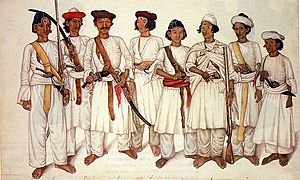
After the British victory in the west, Lord Moira appointed Ochterlony as the main commander for a new offensive. He had 17,000 troops, mostly Indian Sepoys. The British gave Nepal 15 days to agree to a treaty. When Nepal delayed, the British started their second campaign.
In February 1816, Ochterlony took a risky, less-used mountain pass. This allowed the British to attack the Nepalese from behind. Colonel Kelly and Colonel O’Hollorah attacked Hariharpur Gadhi from two directions on February 29. The Nepalese were forced to retreat.
The situation became very difficult for Nepal. This led to a treaty. Major General David Ochterlony received the signed treaty from Nepalese representatives. Two days later, the treaty was officially given to the British in Makawanpur.
The Treaty of Sugauli
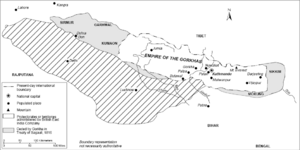
The Treaty of Sugauli was officially agreed upon on March 4, 1816.
- Nepal lost all of Sikkim, and the territories of Kumaon, Garhwal, and Western Terai.
- The Mechi River became Nepal's new eastern border, and the Mahakali river became the western border.
- The British East India Company agreed to pay Nepal 200,000 rupees each year for the lost land.
- The British also placed a "Resident" (a British official) in Kathmandu. However, Nepal's rulers managed to keep the Resident isolated.
Later in 1816, some of the Terai lands were returned to Nepal because they were hard for the British to govern. The annual payments were then stopped. The border issues continued to be discussed for several years. The British did not want to destroy Nepal's independence, as it was a useful buffer between them and China.
Aftermath
Gorkha Recruitment
During the war, British officers like David Ochterlony and William Fraser saw how skilled Nepalese soldiers were. They began recruiting them into the British army. These soldiers were called Gurkhas. The first Gurkha regiments were formed, and they became famous for their bravery and loyalty.
Fate of Key Figures
Bhimsen Thapa
Prime Minister Bhimsen Thapa kept his power in Nepal despite the defeat. He maintained a large, modern army and controlled the court while King Rajendra Bikram Shah was young. However, after the queen regent died in 1832, Bhimsen Thapa started to lose influence. He was later falsely accused of poisoning the prince, which led to problems for his family.
David Ochterlony
David Ochterlony was highly praised for his success in the war. He became the first officer in the British East India Company to receive a special honor, the GCB. He was also made Resident at Delhi. However, after a new Governor-General, Lord Amherst, took over, Ochterlony lost favor. He resigned in 1825 and died shortly after. A memorial was built in his honor, but his biggest legacy is the continued recruitment of Gurkhas into the British and Indian armies.
See also
- Gurkha
- History of Nepal
- Kingdom of Nepal
- Brigade of Gurkhas
- Sino-Nepalese War
- Gurkha–Sikh War
- Nepalese-Tibetan War
- East India Company
- Company rule in India
- Nawab of Awadh
- Garhwali people
- Kumauni people
- Awadh
- Battle of Nalapani
- Treaty of Thapathali
Images for kids
-
Bhakti Thapa (yellow) leading Nepalese Gurkhali Army against British forces
-
Stockaded position of the Nepalese at Jaithak
-
Gorkhali soldiers in 1815 AD.
-
The Treaty of Sugauli 4 March 1816. It suited Ochterlony to bring the campaign to a speedy conclusion because of the approach of the dreaded aul-fever season but also because a number of his European troops were suffering from dysentery.
Sources
Primary sources
- India-Board. (16 August 1815). Dispatches, dated Fort-William, 25 January 1815. The London Gazette. Issue: 17052. Published: 19 Aug 1815. pp. 1–8. [1]
- India-Board. (8 November 1816). Dispatches, dated Fort-William, 30 March 1816. The London Gazette. Issue: 17190. Published: 11 Nov 1816. pp. 1–4. [2]
- East India Company. (1824). Papers respecting the Nepaul War. Papers regarding the administration of the Marquis of Hastings in India. [3]
Secondary sources
- Pemble, John. (2009). Britain's Gorkha War: The Invasion of Nepal, 1814–16. Casemate Pub & Book Dist Llc ISBN: 978-1-84832-520-3.


